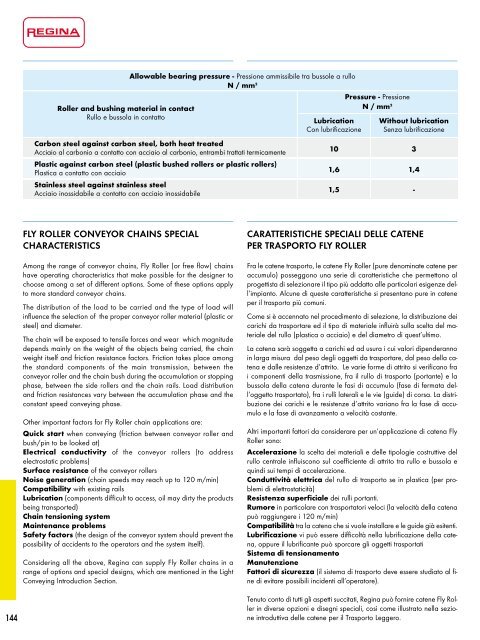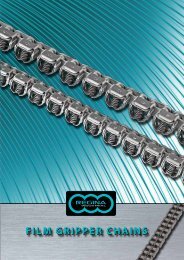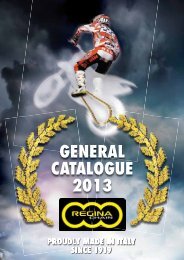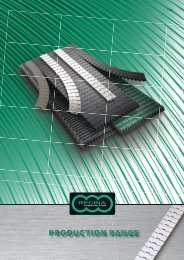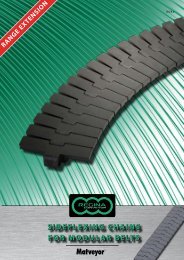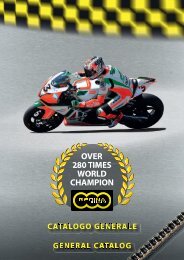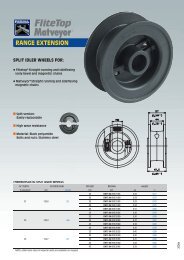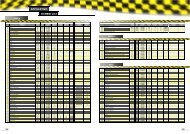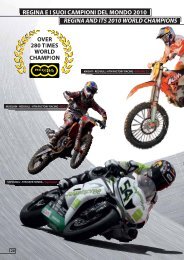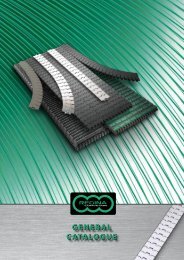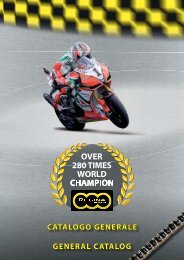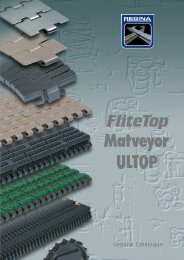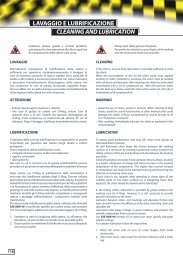Catalogo Generale Industrial - Regina
Catalogo Generale Industrial - Regina
Catalogo Generale Industrial - Regina
You also want an ePaper? Increase the reach of your titles
YUMPU automatically turns print PDFs into web optimized ePapers that Google loves.
Roller and bushing material in contactRullo e bussola in contattoAllowable bearing pressure - Pressione ammissibile tra bussole a rulloN / mm 2Carbon steel against carbon steel, both heat treatedAcciaio al carbonio a contatto con acciaio al carbonio, entrambi trattati termicamentePlastic against carbon steel (plastic bushed rollers or plastic rollers)Plastica a contatto con acciaioStainless steel against stainless steelAcciaio inossidabile a contatto con acciaio inossidabileLubricationCon lubrificazionePressure - PressioneN / mm 2Without lubricationSenza lubrificazione10 31,6 1,41,5 -FLY ROLLER CONVEYOR CHAINS SPECIALCHARACTERISTICSAmong the range of conveyor chains, Fly Roller (or free flow) chainshave operating characteristics that make possible for the designer tochoose among a set of different options. Some of these options applyto more standard conveyor chains.The distribution of the load to be carried and the type of load willinfluence the selection of the proper conveyor roller material (plastic orsteel) and diameter.The chain will be exposed to tensile forces and wear which magnitudedepends mainly on the weight of the objects being carried, the chainweight itself and friction resistance factors. Friction takes place amongthe standard components of the main transmission, between theconveyor roller and the chain bush during the accumulation or stoppingphase, between the side rollers and the chain rails. Load distributionand friction resistances vary between the accumulation phase and theconstant speed conveying phase.Other important factors for Fly Roller chain applications are:Quick start when conveying (friction between conveyor roller andbush/pin to be looked at)Electrical conductivity of the conveyor rollers (to addresselectrostatic problems)Surface resistance of the conveyor rollersNoise generation (chain speeds may reach up to 120 m/min)Compatibility with existing railsLubrication (components difficult to access, oil may dirty the productsbeing transported)Chain tensioning systemMaintenance problemsSafety factors (the design of the conveyor system should prevent thepossibility of accidents to the operators and the system itself).Considering all the above, <strong>Regina</strong> can supply Fly Roller chains in arange of options and special designs, which are mentioned in the LightConveying Introduction Section.CARATTERISTICHE SPECIALI DELLE CATENEPER TRASPORTO FLY ROLLERFra le catene trasporto, le catene Fly Roller (pure denominate catene peraccumulo) posseggono una serie di caratteristiche che permettono alprogettista di selezionare il tipo più addatto alle particolari esigenze dell’impianto.Alcune di queste caratteristiche si presentano pure in cateneper il trasporto più comuni.Come si è accennato nel procedimento di selezione, la distribuzione deicarichi da trasportare ed il tipo di materiale influirà sulla scelta del materialedel rullo (plastica o acciaio) e del diametro di quest’ultimo.La catena sarà soggetta a carichi ed ad usura i cui valori dipenderannoin larga misura dal peso degli oggetti da trasportare, dal peso della catenae dalle resistenze d’attrito. Le varie forme di attrito si verificano frai componenti della trasmissione, fra il rullo di trasporto (portante) e labussola della catena durante le fasi di accumulo (fase di fermata dell’oggettotrasportato), fra i rulli laterali e le vie (guide) di corsa. La distribuzionedei carichi e le resistenze d’attrito variano fra la fase di accumuloe la fase di avanzamento a velocità costante.Altri importanti fattori da considerare per un’applicazione di catena FlyRoller sono:Accelerazione la scelta dei materiali e delle tipologie costruttive delrullo centrale influiscono sul coefficiente di attrito tra rullo e bussola equindi sui tempi di accelerazione.Conduttività elettrica del rullo di trasporto se in plastica (per problemidi elettrostaticità)Resistenza superficiale dei rulli portanti.Rumore in particolare con trasportatori veloci (la velocità della catenapuò raggiungere i 120 m/min)Compatibilità tra la catena che si vuole installare e le guide già esitenti.Lubrificazione vi può essere difficoltà nella lubrificazione della catena,oppure il lubrificante può sporcare gli oggetti trasportatiSistema di tensionamentoManutenzioneFattori di sicurezza (il sistema di trasporto deve essere studiato al finedi evitare possibili incidenti all’operatore).144Tenuto conto di tutti gli aspetti succitati, <strong>Regina</strong> può fornire catene Fly Rollerin diverse opzioni e disegni speciali, così come illustrato nella sezioneintroduttiva delle catene per il Trasporto Leggero.


